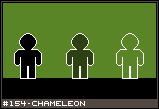|
Mechanic #154 - Chameleon |
 | Posted: 10/04/12
You play as a chameleon, able to take on the colors and shapes of objects behind you. |
![[chameleon1.png]](set08/img/entry154-chameleon1.png)
Fig 154.1 - Shape and Color Locks
This is a simple puzzle game where you play as a stick figure (seen above) that can imprint colors on his body like a chameleon. There are locked doors on the playing field which can only be opened by fitting into a stick figure-like hole in the background to complete the pattern. In this example, the stick figure absorbs the green color. If he were to stand in the hole to the right, completing the green pattern in the background, the door would open and he can continue.
![[chameleon2.png]](set08/img/entry154-chameleon2.png)
Fig 154.2 - Color Blending.
Where it gets a little bit tricky is that the chameleon can only change color in specific zones. In addition to that, the color change is not instant. The color will gradually change, and this process can be stopped halfway. For instance, if you were colored red and stood against a blue zone, your color would move from red to blue through the purple spectrum. If you stopped halfway, you could turn purple, allowing you to open a purple lock.
![[chameleon3.png]](set08/img/entry154-chameleon3.png)
Fig 154.3 - Pattern Creation.
Not only can you accept colors, but you can accept partial colors as well. By standing halfway in the color zone before absorbing the background color, you will only "paint" half of your character that color. By sticking only part of one's body in - or even by striking unusual poses like bending over and sticking your butt in - you can match more complicated patterns.
![[chameleon4.png]](set08/img/entry154-chameleon4.png)
Fig 154.4 - Push Blocks to Block.
Finally, the chameleon only adopts the colors from specified zones. You can push blocks in the way and stand in front of them, allowing only the colors through that are not blocked. This opens up the possibility of manipulating blocks in the right way to create specific shapes. For instance, maybe you have to tilt two blocks together to create a triangle. Or you might have to create a tower to place a long block across the zone so that you color everything but your head.
If you combine posing, color blending, pattern creation, and pushing blocks, I think there are enough possibilities to create a decent puzzle game. |